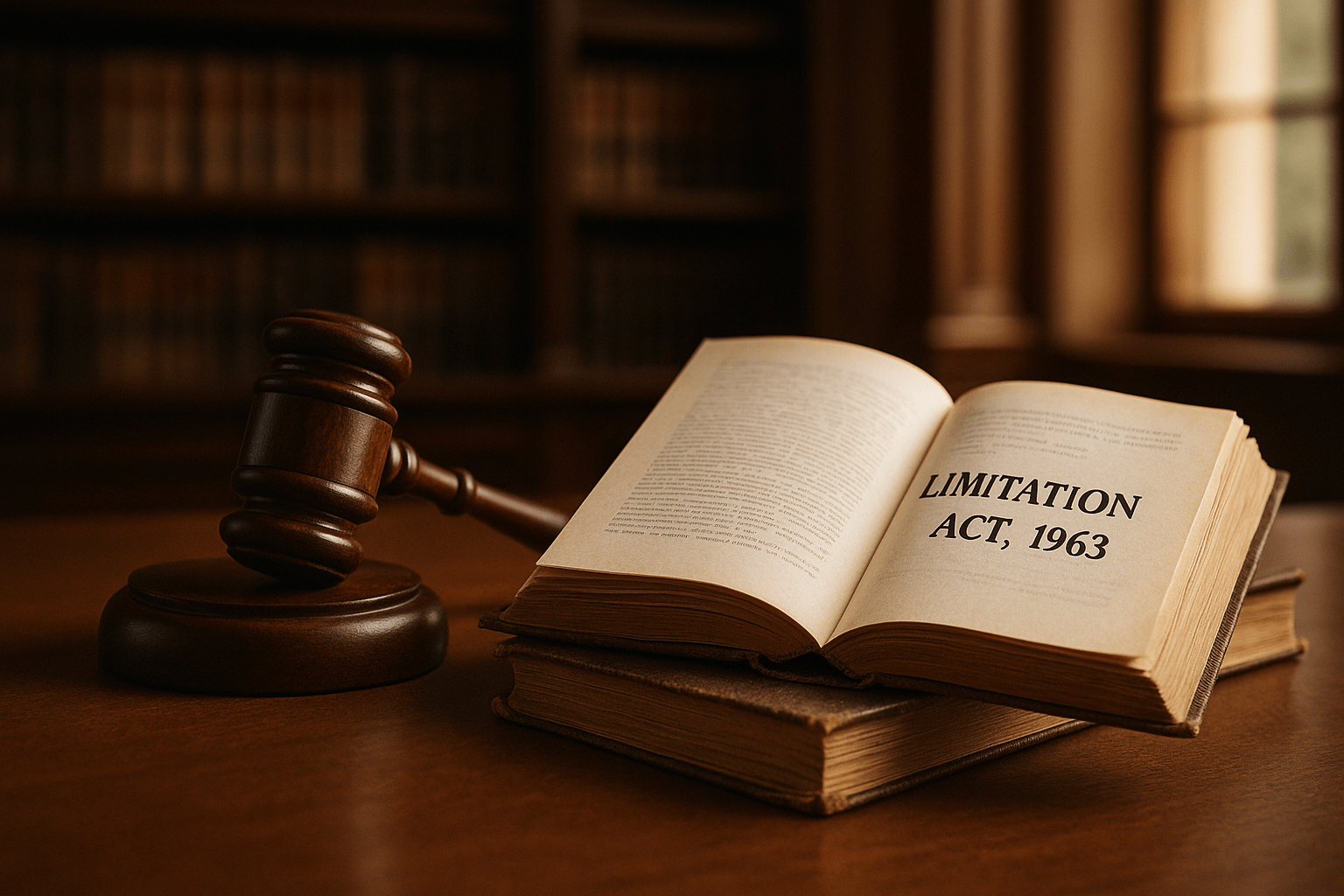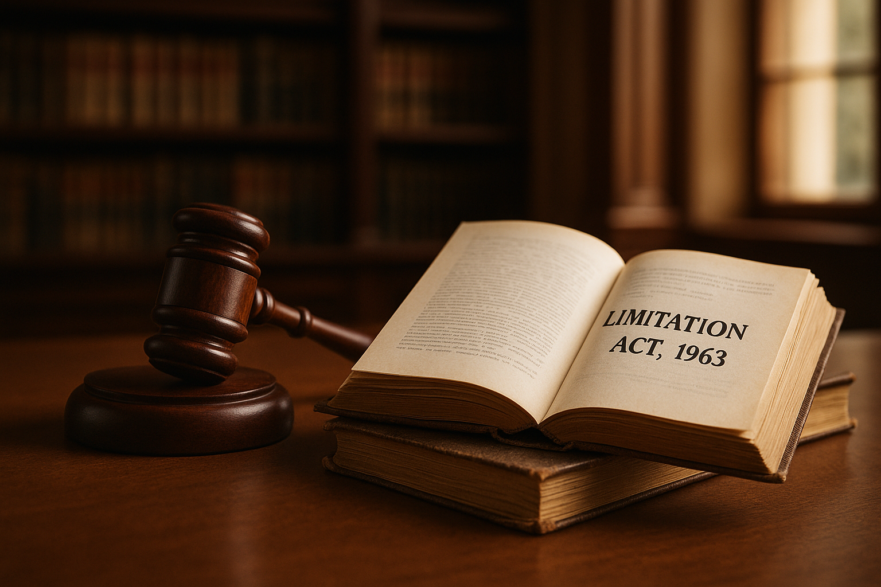
⚖️ LIMITATION ACT: EXTENSION OF PRESCRIBED PERIOD
📚 Supreme Court judgments highlighted in this post:
- Collector Land Acquisition v. Katiji [1987 SC]
- G. Ramegowda v. Spl. Land Acquisition Officer 1988
- O.P. Kathpalia v. Lakhmir Singh [1984]
- Lala Mata Din v. A. Narayanan [1969]
- Shakuntala Devi Jain v. Kuntal Kumari [1969]
- N. Balakrishnan v. M. Krishnamurthy [1998]
- State of Haryana v. Chandra Mani [1996]
- G. Ramegowda v. Spl. Land Acquisition Officer 1988
Preparation for RJS, DJS, PCS (J) and other Judicial Service exams
📘 LIMITATION ACT EXPLAINED — SECTION 5
The Limitation Act is an important component of any and every Judicial Service exam in the country. Its thorough knowledge is a must for all aspirants of RJS, DJS, PCS (J) and every other Judicial Service exam. To help such aspirants, DELHI LAW ACADEMY JAIPUR has launched a series of study material modules on all important aspects of this important part of their syllabus:
🕒 Extension of prescribed period
Section 5
- Any appeal/ application other than under Order XXI CPC may be admitted after the prescribed period
- if the appellant or applicant satisfies the court that he had sufficient cause for not preferring appeal or making application within such period
📝 Explanatory Notes from DLA on section 5:
Question:
Should Courts adopt a liberal approach while interpreting the phrase “sufficient cause”?
Ans:
Case study: Collector Land Acquisition v. Katiji [1987 SC]
📖 Facts of the case
An appeal preferred by the State of J & K against a decision enhancing compensation for acquisition of lands was dismissed as time barred being 4 days beyond time.
⚖️ Courts to do substantial justice
- The legislature has conferred the power to condone delay by enacting section 5 of the Limitation Act in order to enable the Courts to do substantial justice to parties by disposing of matters on ‘merits’.
- The expression “sufficient cause” employed by the legislature is adequately elastic to enable the Courts to apply the law in a meaningful manner which subserves the ends of justice, that being the life-purpose for existence of Courts.
📗 Reasons for a liberal approach
- Refusing to condone delay can result in a meritorious matter being thrown out at the very threshold and cause of justice being defeated. As against this, when delay is condoned the highest that can happen is that a cause would be decided on merits after hearing the parties.
- When substantial justice and technical considerations are pitted against each other, cause of substantial justice deserves to be preferred, for the other side cannot claim to have vested right in injustice being done because of a non-deliberate delay.
- There is no presumption that delay is occasioned deliberately or on account of culpable negligence or on account of malafides. A litigant does not stand to benefit by resorting to delay. In fact he runs a serious risk.
- Judiciary is respected not on account of its power to legalize injustice on technical grounds but because it is capable of removing injustice and is expected to do so.
Supreme Court in G. Ramegowda v. Spl. Land Acquisition Officer 1988:
The expression “sufficient cause” must receive a liberal construction so as to advance substantial justice and generally delays in preferring the appeals are required to be condoned in the interest of justice where no gross negligence or deliberate inaction or lack of bona fides is imputable to the party seeking condonation of delay.
Supreme Court in O.P. Kathpalia v. Lakhmir Singh [1984]:
If the refusal to condone the delay results in grave miscarriage of justice, it would be a ground to condone the delay.
Supreme Court in Lala Mata Din v. A. Narayanan [1969]:
There is no general proposition that mistake of counsel by itself is always sufficient cause for condonation of delay. It is always a question whether the mistake was bona fide or was merely a device to cover an ulterior purpose.
Privy Council in Brij Indar Singh v. Kanshi Ram [1917]:
The true guide for a court to exercise the discretion u/s 5 is whether the appellant acted with reasonable diligence in prosecuting the appeal.
Supreme Court in Shakuntala Devi Jain v. Kuntal Kumari [1969]:
Unless want of bona fides of such inaction or negligence as would deprive a party of the protection of Section 5 is proved, the application must not be thrown out or any delay cannot be refused to be condoned.
Supreme Court in N. Balakrishnan v. M. Krishnamurthy [1998]:
Section 5 is to be construed liberally so as to do substantial justice to the parties. The provision contemplates that the court has to go in the position of the person concerned and to find out if the delay can be said to have resulted from the cause which he had adduced and whether the cause can be recorded in the peculiar circumstances of the case as sufficient.
Question:
Should Courts adopt a strict approach in matters of condonation of delay when State is a litigating party?
Ans:
The fact that it was the ‘State’ which was seeking condonation and not a private party was altogether irrelevant. The doctrine of equality before law demands that all litigants, including the State as a litigant, are accorded the same treatment and the law is administered in an even-handed manner.
In fact experience shows that on account of an impersonal machinery (no one in charge of matter is directly hit or hurt by the judgment sought to be subjected to appeal) and the inherited bureaucratic methodology imbued with note-making, file pushing and passing-on-the-buck methods, delay on its part is less difficult to understand though more difficult to approve. In any event, the State which represents the collective cause of the community does not deserve a litigant non grata status.
Authority: Collector Land Acquisition v. Katiji [1987 SC]
Supreme Court in State of Haryana v. Chandra Mani [1996]:
Adoption of strict standard of proof sometimes fails to protect public justice, and it would result in public mischief by skilful management of delay in the process of filing an appeal. If the appeals brought by the State are lost for such default no person is individually affected but what in the ultimate analysis suffers, is public interest. The expression “sufficient cause” should, therefore, be considered with pragmatism in a justice-oriented approach rather than the technical detection of sufficient cause for explaining every day’s delay. The factors which are peculiar to and characteristic of the functioning of the governmental conditions would be cognizant to and requires adoption of pragmatic approach in justice-oriented process. The court should decide the matters on merits unless the case is hopelessly without merit.
Supreme Court in G. Ramegowda v. Spl. Land Acquisition Officer 1988:
If appeals brought by Government are lost for such defaults, no person is individually affected, but what, in the ultimate analysis, suffers is public interest. A somewhat different complexion is imparted to the matter where Government makes out a case where public interest was shown to have suffered owing to acts of fraud or bad faith on the part of its officers or agents and where the officers were clearly at cross-purposes with it. Government decisions are proverbially slow encumbered, as they are, by a considerable degree of procedural red tape in the process of their making. A certain amount of latitude is, therefore, not impermissible. Implicit in the very nature of governmental functioning is procedural delay incidental to the decision-making process.
📚 Continue Your Limitation Act Preparation
Don’t stop here! Strengthen your knowledge of the Limitation Act with our other fully solved tests:
📘 Free Study Material for Judiciary Aspirants!
Download our FREE study material prepared by Delhi Law Academy’s expert faculty.
❓ Frequently Asked Questions on Section 5 of the Limitation Act
📘 What does Section 5 of the Limitation Act deal with?
Section 5 permits courts to admit an appeal or application even after the limitation period, if the applicant shows “sufficient cause” for not filing within time. It applies to all appeals and applications (other than those under Order XXI CPC).
⚖️ What is meant by “sufficient cause” under Section 5?
The term “sufficient cause” is interpreted liberally to ensure justice. Courts should adopt a justice-oriented approach instead of a technical one, as held in Collector Land Acquisition v. Katiji (1987).
🧾 Does the State get special treatment in condonation of delay cases?
No 🚫 The State is to be treated like any other litigant. However, in State of Haryana v. Chandra Mani (1996), the Court acknowledged that bureaucratic delays may justify a pragmatic approach to “sufficient cause.”
⏳ What happens if delay is condoned by the court?
The case is heard on merits instead of being dismissed on technical grounds. Courts prefer substantial justice over rigid procedure.
👩⚖️ Can a lawyer’s mistake be a ground for condonation of delay?
In Lala Mata Din v. A. Narayanan (1969), the Court held that a lawyer’s mistake is a sufficient cause only if it was bona fide and not a deliberate device to delay proceedings.
📚 How should Judicial Service aspirants study Section 5 of the Limitation Act?
Focus on landmark cases like Katiji (1987), Ramegowda (1988) and N. Balakrishnan (1998). Understand how courts balance technical delays with the goal of substantial justice — a frequent exam theme in RJS/DJS/PCS(J).
Contact us
📍 Delhi Law Academy – Jaipur Branch
6C, Tower 2, Coaching Hub, Pratap Nagar, Jaipur – 302033
📞 Phone:
+91 9911916552
+91 8447285606
✉️ Email:
contactus@delhilawacademy.com

